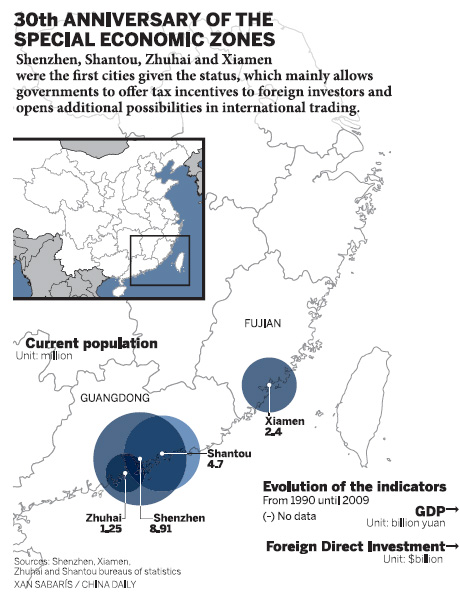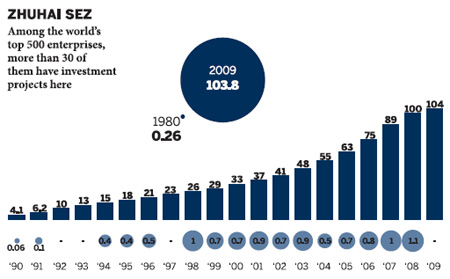Focus
Prosperous zones look to the future
By Meng Jing (China Daily)
Updated: 2010-08-26 15:52
 |
Large Medium Small |

Our series on the nation's SEZs begins with a look at the changing fortunes of an island in Zhuhai. Meng Jing reports.
There is a saying in Guangdong province that the two most painful experiences are living on Hengqin island and dying on Mangzhou island.
The former was notorious for its extreme poverty while the latter, now part of Taishan city in Guangdong, was a wartime execution ground in the 1930s.
Although part of Zhuhai, one of China's first special economic zones (SEZs) and now a prosperous city, Hengqin was not part of the original zone and remains relatively unchanged since the early 1980s.
However, there is now a growing sense of optimism and, as the country marks the 30th anniversary of its groundbreaking SEZs on Thursday, the island is set to join the party.
Following last year's decision to redraw the Zhuhai zone boundary to include Hengqin, soon to boast a new campus of the University of Macao, residents have been eagerly building houses to rent out to the army of migrant workers who will inevitably arrive to work on the infrastructure and development projects.
| ||||
Hengqin is the largest of Zhuhai's 146 islands but for decades residents relied largely on Macao, just a 10-minute boat ride away.
"Most of the time we rowed boats to Macao, taking fish, fruit and firewood and bringing back rice, oil and clothes," said 80-year-old Lin Beitian, who moved to the island with his mother and three siblings in 1936.
"We were so poor at the time," he said, explaining that about 500 of Hengqin's 3,000 inhabitants fled to Macao illegally when access was blocked during the "cultural revolution" (1966-1976). "Most people didn't think they could survive."
Since 1980, Zhuhai has seen its population surge from 120,000 to 1.45 million. GDP has also increased by an average of 20 percent year-on-year, hitting 103 billion yuan ($15 billion) last year.
Yet, although per capita GDP in Zhuhai has jumped to more than 69,000 yuan a year, in Hengqin it is still barely 9,000 yuan.
A 1,425-meter bridge, the sole link from the island to Zhuhai's modern downtown, was not completed until 1999, and the No 14 bus is the only form of public transport.
No courier companies deliver to the area and even the Agricultural Bank of China, the only one on the island before 2010, closed its branch years ago.
The lack of progress has been a source of frustration for residents. Although forests, wetlands and rare mangroves dominate more than half of the 106-sq-km island, for some the natural beauty cannot compare with the gleaming Hotel Lisboa or the futuristic 338-meter-tall Macao Tower, both of which can be easily seen across the water in Macao.
Lin said his two daughters, who were born in Macao because there was no hospital on Hengqin at the time, moved their families to Macao permanently in the 1980s.
"They invite me to have dinner but they seldom come back here," said the pensioner. "Even if they do, they never stay overnight. They don't like it here."
However, life in Hengqin has begun to change since August last year, when central authorities approved plans to make the island China's third State-level strategic new area, putting it alongside Shanghai's Pudong district and Binhai in Tianjin.
"Macao was just like here in the late 1970s," said islander Xu Jianxin, 42. "Macao changed but Hengqin stayed the same. Now it's finally our turn."

Ringing the changes
Due to its location, the new area will act as a platform to promote new cooperation between Hong Kong, Macao and Guangdong under the "one country, two systems" policy.
The 1,700-meter Lianhua Bridge already links Hengqin with Macao, while the Hong Kong-Zhuhai-Macao Bridge, which is set for completion in 2015, will cut travel times to Hong Kong to 30 minutes by road, as opposed to one hour by boat.
According to Fan Hengshan, director of the National Development and Reform Commission's regional economy department, the pilot project will ease the land and workforce shortages in Hong Kong and Macao.
"The development relies on the money, techniques and experience from the surrounding areas, especially Hong Kong and Macao," he said.
Officials in Hengqin, which is three times the size of Macao and has a population of about 10,000, have already launched six huge projects and attracted 70 billion yuan in investment. (One of the projects is the 1.1-square-kilometer campus, which has been leased to the University of Macao for 40 years. The city's oldest college has found it increasingly difficult to house all 6,600 students and 400 teaching staff on its original grounds.)
According to the blueprint, the new area will increase its population by 120,000 by 2015 and 280,000 by 2020, with per capita GDP also expected to rise to 120,000 yuan and 200,000 yuan over the same periods.
New industries will focus on business services, leisure, tourism, education, high technology and research and development.
People living in the island's 10 villages say they have already started to see major changes, including the opening of branches by the Bank of China and China Post.
About 50 percent of residents are now building properties. Most four-story blocks have been torn down and replaced by new six-story blocks, and advertisements for apartments to rent are on view almost everywhere.
"There will be 120,000 people living here by 2015 according to the plan," said an excited Xu Jianxin. "Let's say 60,000 live outside Hengqin and 30,000 on the construction sites, that leaves 30,000 who need to find somewhere to live."
Ding Wenli, who arrived in Hengqin more than 18 months ago for the fishing, said the average price of a two-bedroom apartment has already increased from about 800 yuan a month in 2009 to 1,000 yuan this year.
"The natives seldom fish or farm anymore," said Ding, who is from Yangjiang in Guangdong. "With the houses they have, they're rich now."
Each household in Hengqin owns roughly 80 to 100 square meters of property and most are intending to make the most of it.
The reconstruction fever began in earnest two years ago when Guangzhou Chime Long Group opened negotiations with residents in two villages over demolition compensation, said Liu Shuqiong, who came to Hengqin with her husband and a 16-member construction team in 2006.
"That was when we knew the development plan was for real," she said. "About 20 to 30 bosses are now doing the business in Hengqin and each of them has a team of 40 to 50 workers," she said.
Liu said her team has worked on several projects in Shenzhen, a major city in Guangdong, since 1992 but added: "Business in Shenzhen has shrunk. After 2004, we could hardly find any work. That's why we came to Zhuhai."
The cost of building a six-story house in Hengqin is around 1,000 yuan per square meter and many residents insist on building higher properties, even those short on cash.
"They can either rent them out or get much more compensation once it gets demolished," said Liu, who originally hails from Sichuan province. She has invested in two houses in Hengqin, the profits from which she will split with village partners. "I've always followed the news about Hengqin's development," she added. "I think this place is the future of Zhuhai."


